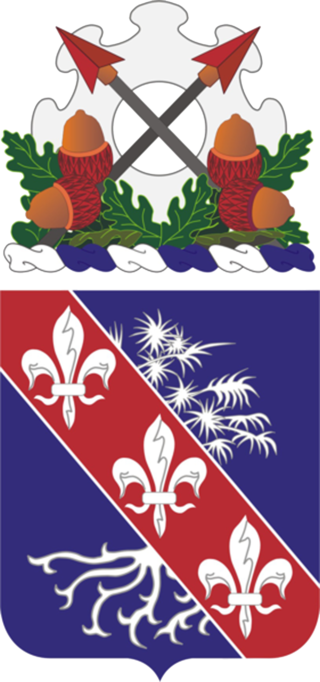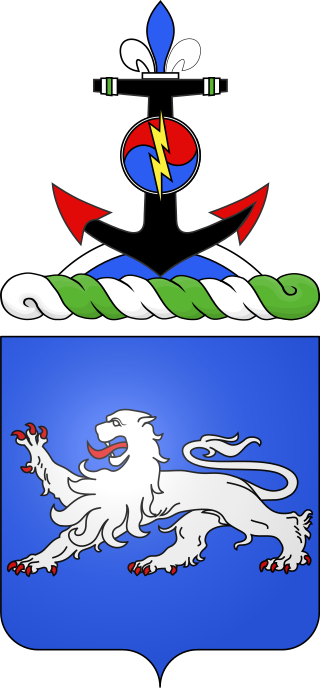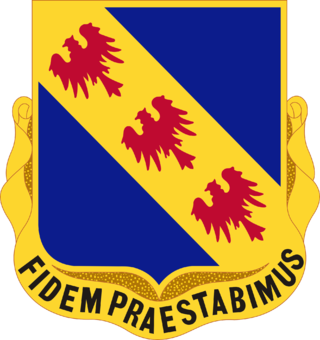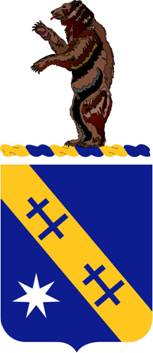
The 87th Infantry Division was a unit of the United States Army in World War I and World War II.

The 89th Infantry Division, originally known as the "89th Division," was an infantry formation of the United States Army that was active during World War I, World War II, and the Cold War.

The 79th Infantry Division was an infantry formation of the United States Army Reserve in World Wars I and II.

The 81st Readiness Division ("Wildcat") was a formation of the United States Army originally organized as the 81st Infantry Division during World War I. After World War I, the 81st Division was allotted to the Organized Reserve as a "skeletonized" cadre division. In 1942, the division was reactivated and reorganized as the 81st Infantry Division and served in the Pacific during World War II. After World War II, the 81st Infantry Division was allotted to the Organized Reserve as a Class C cadre division, and stationed at Atlanta, Georgia. The 81st Infantry Division saw no active service during the Cold War and was inactivated in 1965.

The 39th Infantry Regiment is a parent regiment in the United States Army. Originally organized for service in World War I, the 39th fought in most of the conflicts involving the United States during the 20th century, and since 1990 the 2nd Battalion has served as a training unit stationed at Fort Jackson, South Carolina. The 3rd Battalion was started on 21 October 2015 and a 4th Battalion was added in July 2017.

The 327th Infantry Regiment is an infantry regiment of the 101st Airborne Division of the United States Army. During World War II, the 327th was a glider-borne regiment of the 101st Airborne Division. It fought during World War I as part of the 82nd Division. It has also been deployed in the Vietnam War, Gulf War, and most recently to Iraq and Afghanistan. The song "Glider Rider" describes (humorously) some of the slights that glider-borne troops felt they received from the Army during World War II; though the regiment's public fame rose with the 1949 movie Battleground about the Siege of Bastogne in late 1944.
The 54th Infantry Regiment is a United States Army Regimental System parent regiment of the United States Army. It is represented in the active Army by the 2nd and 3rd Battalions, which conduct Infantry One Station Unit Training (OSUT) at Fort Moore, Georgia.
The 5th Brigade, 78th Division was an AC/RC unit based at Joint Base McGuire–Dix–Lakehurst, New Jersey. The unit was responsible for training selected United States Army Reserve and National Guard units along the East coast. The brigade was a subordinate unit of First Army Division East, First United States Army when it was inactivated in 2006.

The 157th Infantry Brigade is an active/reserve component (AC/RC) unit based at Camp Atterbury, Indiana. The unit is responsible for training selected United States Army Reserve and National Guard units. The unit was activated using the assets of the 5th Brigade, 87th Division. The brigade is a subordinate unit of First Army Division East.
The 314th Infantry Regiment is an infantry regiment of the U.S. Army first organized in 1917.

The 68th Armor Regiment is an armored regiment of the United States Army. It was first activated in 1933 in the Regular Army as the 68th Infantry Regiment.

The 38th Infantry Regiment is a United States Army infantry regiment.

The 355th Infantry Regiment is an infantry regiment of the United States Army. The 1st Battalion of the regiment an active unit of the United States Army Reserve.

The 59th Infantry Regiment was a regiment of the United States Army first established in 1917.

The 113th Infantry Regiment is an Infantry regiment of the New Jersey Army National Guard. It is one of several National Guard units with colonial roots and campaign credit for the War of 1812.
The 307th Infantry Regiment was a National Army unit first organized for service in World War I as part of the 77th Division in France. It later served in the Pacific Theater during World War II. Since then it has served as a training Regiment. In 1999, it was withdrawn from the Combat Arms Regimental System and redesignated as a non-branch regiment. The regiment's 1st Battalion is assigned to the 174th Infantry Brigade at Joint Base McGuire–Dix–Lakehurst, New Jersey, with the 2nd Battalion is assigned to the 157th Infantry Brigade at Camp Atterbury, Indiana.
The 308th Infantry Regiment was a unit in the United States Army during World War I as a part of the 77th Infantry Division in Europe. Regimental designation is used only in historical tradition.

The 140th Infantry Regiment was an infantry formation of the Missouri National Guard.
The 306th Infantry Regiment was a National Army unit first organized for service in World War I as part of the 77th Infantry Division in Europe. It later served in the Pacific Theater during World War II. Since then it has served as a training Regiment. In 1999, it was withdrawn from the Combat Arms Regimental System and redesignated as a non-branch regiment. The regiment's 1st, 2nd, 4th, and 5th battalions are stationed at Fort Stewart under the command of the 188th Infantry Brigade. The 3rd Battalion is inactive.
The 305th Infantry Regiment was a National Army unit first organized for service in World War I as part of the 77th Infantry Division in Europe. It later served in the Pacific Theater during World War II. Since then it has served as a training Regiment. In 1999, it was withdrawn from the Combat Arms Regimental System and redesignated as a non-branch regiment. The regiment's 1st and 2nd battalions are stationed at Camp Shelby under the command of the 177th Armored Brigade. The regiment's 3rd battalion is inactive.















